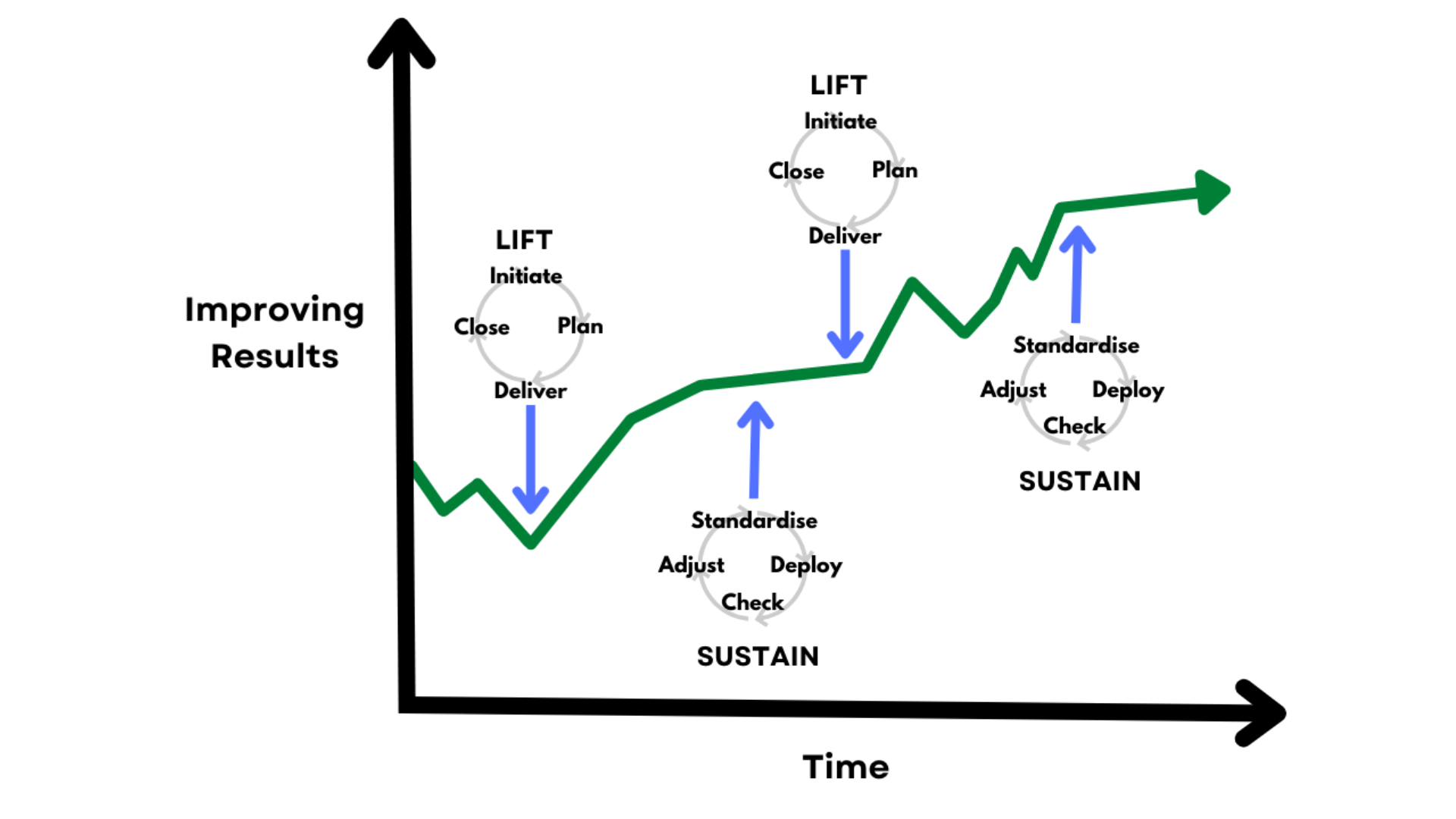Dis-Continuous Improvement is the goal.
Lift, then Sustain, then do it again - Dis-Continuous Improvement
For over 20years we have promoted and taught 'Continuous Improvement' to help organisations improve results & perform better. But now I realise that's the wrong way of thinking. I'd like to apologise. 'Continuous Improvement' is actually unhelpful, if you think about it. It's a logical nonsense, and, actually, really hard to implement.
What organisations actually need is ‘Dis-Continuous Improvement.’ We want to Lift, and then Sustain results. And then do it again, in a planned sequence, when required. That's the real secret to improving performance and getting better business results.
Why ‘Dis-Continuous Improvement’? Just imagine a workplace where everything is improving, all the time, everywhere. While it sounds good, in practice it would actually be utter chaos!
For a start, how would you plan. What if you didn't know, roughly, how many widgets you were producing each day, but it may or may not keep going up? How much raw material do you order? How many cases to pack them in? How many pallet spaces do you keep spare? How many delivery trucks do you schedule?
Then, how would you ensure quality and compliance are maintained? Every organisation has 'standards' that help ensure compliance to something. Maybe ISO Standards, maybe Industry Codes of Conduct/Practice, maybe Legislation, maybe some form of accreditation. We capture our quality & compliance standards in Standard Operating Procedures, or Control Points, or something. How do we do this if what we are doing is continually changing?
Some processes have physical limits that simply cannot be negotiated (improved). There are often physical constraints that, if pushed against, will cause quality issues, or non-compliance, or unwanted consequences. Think of a fryer, or oven. There is a maximum thermal input. Trying to push more product through, faster, than the recipe calls for is possible, but means reducing dwell times, and changing the finished product profile. Or setting the forming rollers at the upper limit of the specification. There's always some way to tamper with the system to get so-called "improved results". We actually saw this at a famous biscuit maker - "consultants" had introduced an 'Award Room', as part of their 'Operational Excellence' program. There were awards for "Most Kilograms of Biscuits in a Shift." As an ex-Production Manager I know how to win this award. Also, as an ex-QA Manager, I know what the consequences are. When we were invited on a factory tour, we saw the Award Room, and the Production Line, and sure enough, oven conveyor belts were 'speeded up', oven temperatures lifted above specified settings, and lo-and-behold, lots of kilograms of biscuits burnt at the edges, undercooked in the middle, and an award-winning kilogram output.
There are many other downsides to unplanned 'continuous improvement' everywhere - I'm sure you could now think of many in your industry or organisation.
But we do want to improve performance. We want to continually improve results. And the answer is actually 'Dis-Continuous Improvement.' We want improvement to happen in cycles, that we plan, and your Executive Team have control, and can repeat consistently across the organisation, across all functions. We want to LIFT results, and then SUSTAIN these results. We want to Initiate improvements, according to a PLAN, or for a reason, or to achieve a planned target. We want to STANDARDISE these improved results, so we can PLAN & deliver a predictable, consistent, repeatable product or service. You get the picture. Improvement should be like a "Ratchet" mechanism - Lift & Sustain, Lift & Sustain, in repeatable cycles.
This where the 'FAST' System comes in. We Lift and Sustain results, 40% Faster, in 120-day Cycles. To learn more about the FAST System, visit www.performanceframeworks.com , or www.justperformance.net.au.


